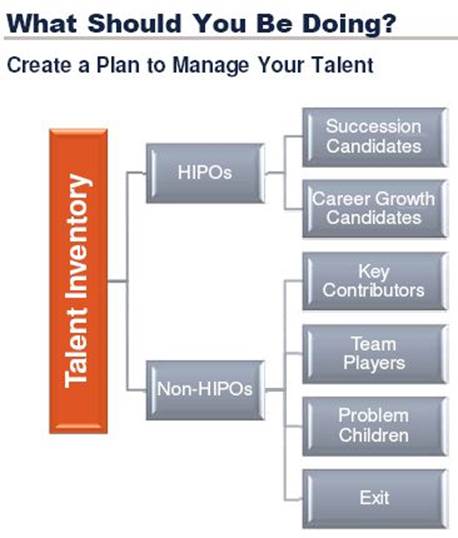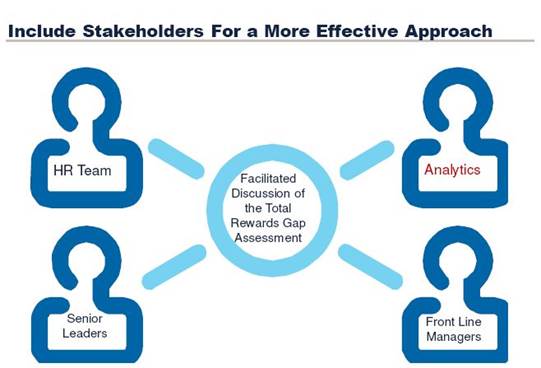Yesterday’s Advisor covered consultant Jennifer Barton’s, SPHR, tips for evaluating your total rewards program. Today, what you can do to make your program more effective.
 |
Start by taking a talent inventory, says Barton, who is Chief Operating Officer, Willis North America Human Capital Practice. She made her suggestions at the recent SHRM Annual Conference and Exposition in Orlando. You might start by populating a chart such as this, she says:

Then think about what you can offer each type of employee:
- Projects
- Taskforce membership
- Job rotations
- Temporary accountability
- Stretch assignments
- Fix-it/turn-around
- Development plans
- Cross-functional moves
- Internal and external leadership development
- 360◦ feedback
You‘ll have more success if you include stakeholders in your evaluations and planning, Barton says.

Start with Some Open-Ended Questions
Also, says Barton, answer some questions about your program:
- What are our key challenges with respect to attracting, retaining, and motivating the right talent?
- What is our current employer-employee value proposition?
- What makes our organization an attractive place to work? Why do employees stay?
- Why do employees leave?
- What message is our current total rewards program sending to employees?
- What message should it be sending?
Last chance to enter your HR innovation for the HR Innovator Awards. Get recognized for your contributions to the profession. Final deadline for entries is August 30. Details and entry form here.
Prioritize
Identify core elements (3 to 5 rewards), Barton says, that your organization can use to drive recruitment, retention, and engagement of talent.
Evaluate your choices:
- Would delivering on this program help our organization achieve strategic objectives?
- Are line managers likely to cooperate if asked to support the delivery of this program?
- Would senior leaders at our organization see the link between this program and business objectives?
- Do we have the capabilities within our HR team to deliver this program well?
- Do we have the infrastructure (e.g., technology, tools) to deliver this program well?
- Can we secure the budget necessary to deliver this program well?
- Can we commit to delivering on this program long-term?
- Should we terminate the program because it adds little actual or perceived value? What would be the impact of termination to recruitment, retention, and motivation?
Communicate
Honest, clear, and consistent communications about positive and negative developments help maintain leadership’s credibility and build confidence in management. Many times, says Barton, employers are doing the right things but employees don’t know about it.
Who Does What?
Barton shows the communication tasks for managers at all levels:
|
Level |
Communication Role |
|
CEO and C-Suite |
|
|
Directors and Senior Leadership 25 to 100 key leaders |
|
|
Managers and Supervisors 10 to 100 to 1,000 managers |
|
Final Tip
Remember that it’s an ongoing process, says Barton.
Have you found an innovative way to manage total rewards—or any other HR or compensation-related activity?
Final Call: HRDA HR Innovator Awards
Get recognized for your outstanding HR innovations! HRDA’s HR Innovator Awards recognize individuals or organizations who have devised and implemented innovative strategies and techniques for solving HR problems or meeting other HR challenges. Winning entries will have a substantial return on investment or a substantial positive effect on HR operations and productivity. But enter now—the final deadline is fast approaching. Details and entry form here.
Final deadline for the HR Innovator Awards! Get recognized for your contributions to the HR profession. All entries must be in by August 30. Details and entry form here.
The award program is open to any HR practitioner or HR department. What’s in it for you and your organization?
- Demonstrates your desire to be an outstanding HR professional.
- Showcases your and your organization’s innovative thinking.
- Provides recognition—for yourself, within your organization and with your professional peers, and for your organization.
- Enhances your organization’s employer brand.
- Allows you to make a significant contribution to your profession as others are inspired by your innovation.
- Provides positive publicity, as winners will be announced through news media, social media, and to the
- Daily Advisor 240,000 subscriber base.
- Allows use of the winners’ logo.
Want to be recognized? The deadline for entries is upon us. The entry process is clear and straightforward, but you have to do it now before the final deadline of August 30. Details and entry form here.

80% of employees self-report that they are not engaged.
80% of managers are ill suited to effectively manage people.
The two 80 percents are closely related.
Successful employees have all three of the following success predictors while unsuccessful employee lack one or two and usually it is Job Talent that they lack.
1. Competence
2. Cultural Fit
3. Job Talent
Employers do a…
A. GREAT job of hiring competent employees.
B. good job of hiring competent employees who fit the culture.
C. POOR job of hiring competent employees who fit the culture and who have a talent for the job.
Identifying the talent required for each job seems to be missing from talent and management discussions. If we ignore any of the three criteria, our workforce will be less successful with higher turnover than if we do not ignore any of the three criteria.
1. Competence
2. Cultural Fit
3. Talent
There are many factors to consider when hiring and managing talent but first we need to define talent unless “hiring talent” means “hiring employees.” Everyone wants to hire for and manage talent but if we can’t answer the five questions below with specificity, we can’t hire or manage talent effectively.
1. How do we define talent?
2. How do we measure talent?
3. How do we know a candidate’s talent?
4. How do we know what talent is required for each job?
5. How do we match a candidate’s talent to the talent demanded by the job?
Most managers cannot answer the five questions with specificity but the answers provide the framework for hiring successful employees and creating an engaged workforce.
Talent is not found in resumes or interviews or background checks or college transcripts.
Talent must be hired since it cannot be acquired or imparted after the hire.